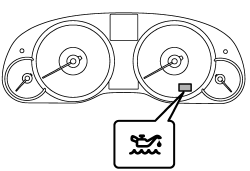Subaru Outback (BR): Engine oil

NOTE
● When the engine low oil level warning light illuminates, have your vehicle
inspected by your SUBARU dealer as soon as possible.
● The engine oil consumption rate is not stabilized, and therefore cannot be
determined until the vehicle has traveled at least several thousand miles (kilometers).
Even after break-in, when the vehicle is used under severe driving conditions such
as those mentioned in the Warranty and Maintenance Booklet, engine oil is consumed
or deteriorated more quickly than under normal driving conditions. If you drive
your vehicle under these severe conditions, you should check the oil level at least
at every second fuel fill-up time, and change the oil more frequently. Please refer
to the Warranty and Maintenance Booklet for more details.
● If the oil consumption rate seems abnormally high after the break-in period,
for example more than 1 quart per 1,200 miles or 1 liter per 2,000 kilometers, we
recommend that you contact your SUBARU dealer.
READ NEXT:
Check the engine oil level at each fuel stop.
1. Park the vehicle on a level surface and stop the engine. If you check the
oil level just after stopping the engine, wait a few minutes for the oil t
Change the oil and oil filter according to the maintenance schedule in the “Warranty
and Maintenance Booklet”.
The engine oil and oil filter must be changed more frequently than listed in
the
CAUTION
Use only engine oil with the recommended grade and viscosity.
NOTE
Engine oil viscosity (thickness) affects fuel economy. Oils of lower viscosity
provide better fuel economy. However, in
SEE MORE:
CZ:DTC P1152 O2 SENSOR CIRCUIT RANGE/PERFORMANCE (LOW) (BANK1
SENSOR1)
1. OUTLINE OF DIAGNOSIS
Detect that λ value remains low.
Judge as NG when lambda value is abnormal in accordance with λ value of front
oxygen (A/F) sensor and
running conditions such as vehicle speed, amount of intake
A: REMOVAL
1) Disconnect the ground cable from battery.
2) Remove the cover (A) and clip (B) from air intake
boot assembly.
3) Loosen the clamp (A) which connects the air intake
boot assembly and air cleaner case.
4) Loosen the clamp (B) which connects the air intake
boot assembly and throttle bo
© 2010-2025 Copyright www.suoutback.com



